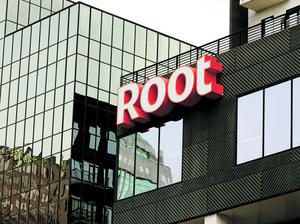
For 2021, Root Inc. reported a $521 million net loss – its year of "peak cash burn," which if repeated would have depleted reserves by the end of this year.
Today the drainage has slowed to a trickle, and Root Insurance Co. has increased marketing to grow customers again. Instead of the grow-at-all-costs mode of a venture-backed company, the digital insurer's new ethos is “grow, but profitably.”
“The board, and internally, everyone is really very pleased with what we’ve accomplished here – (compared) with where we were two years ago,” co-founder and CEO Alex Timm said in an interview. “What we said would happen is happening.”
Columbus-based Root (Nasdaq: ROOT) remains on track to turn profitable sometime in 2024 without taking on more debt or seeking dilutive sources of capital, Timm and CFO Megan Binkley told analysts last week. Year-to-date cash burn is half that of last year, while the ratio of claims losses to premiums is holding steady despite growth in new business.
"We certainly have a near-term path to profitability," Timm told me. "We aren’t pinpointing a quarter."
The company's aspiration doesn't stop at hitting that inflection point, Timm said.
"We want to be much better than breakeven," he said. "We believe we can become a very, very big company."
That's an uphill climb. Today's market capitalization of more than $151 million is 2% of the $7 billion valuation at its October 2020 IPO, and not even one-third of the $528 million in VC raised before going public.
After the losses of Root's first full year on the market, BlackRock provided a $300 million credit facility, but at a cost. The baseline interest is the benchmark set by finanical institutions based on Treasuries, plus a whopping 9%. A pre-payment penalty applies until mid-2024.
“When we took that loan out, the company looked very, very different,” Timm said.
Later next year, refinancing options could open up.
Since the loan, Root slashed expenses, including hundreds of job cuts. All or part of its downtown Columbus office is offered for sublease, although there are no takers yet.
“There was a lot of advice given to entrepreneurs (before 2022): 'Grow, grow, grow; don’t worry about profit,'” Timm said. “Now that money isn’t free, you’re seeing the tide go out on venture capital in a big, big way. We are in many ways lucky – we saw that trend happen early. We built a big enough company to take ourselves profitable."
By this spring, Root had one-third fewer policyholders than at the time of the IPO. But the past two quarters it increased marketing spending, and the chart of members by quarter started to tick up in a U shape.
“We know we want to be national. We (had) put that on the back burner,” Timm said. “We’re not in that position anymore – we’re back in growth mode.”
Scrutiny of its finances and criticism from shareholders are among the downsides of going public, but it was still the right move, Timm said.
"It forced us to deal with the hard realties faster and it forced us to a level of discipline," he said. "We are forever a better company because of it."






